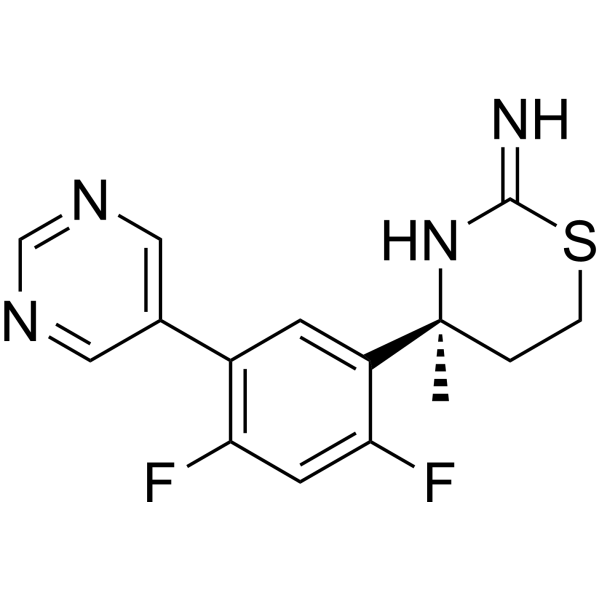Home
Products
LY2811376



| Product Name | LY2811376 |
| Price: | Inquiry |
| Catalog No.: | CN00130 |
| CAS No.: | 1194044-20-6 |
| Molecular Formula: | C15H14F2N4S |
| Molecular Weight: | 320.36 g/mol |
| Purity: | >=98% |
| Type of Compound: | Alkaloids |
| Physical Desc.: | Powder |
| Source: | |
| Solvent: | Chloroform, Dichloromethane, Ethyl Acetate, DMSO, Acetone, etc. |
| SMILES: | NC1=N[C@](CCS1)(C)c1cc(c2cncnc2)c(cc1F)F |
| Contact us | |
|---|---|
| First Name: | |
| Last Name: | |
| E-mail: | |
| Question: | |
| Description | LY2811376 is the first orally available non-peptidic β-secretase (BACE1) inhibitor with IC50 of 239 nM-249 nM, that acts to decrease Aβ secretion with EC50 of 300 nM, and demonstrates to have 10-fold selectivity towards BACE1 over BACE2, and more than 50-fold inhibition over other aspartic proteases including cathepsin D, pepsin, or renin. |
| Target | IC50: 239-249 nM (BACE1) |
| In Vitro | In an APP-overexpressing human embryonic kidney cell line, LY2811376 treatment yields a concentration-dependent decrease in Aβ secretion with a half-maximal effective concentration (EC50) of appr 300 nM. LY2811376 treatment of primary neuronal cultures of PDAPP transgenic mouse produces a concentration-dependent decrease in Aβ secretion with an EC50 of appr 100 nM[1]. LY2811376 has good ADME properties (BACE1 IC50=240 nM, cellular potency IC50=300 nM) and selectivity (BACE2 and cathepsin D selectivity: appr 10- and 65-fold, respectively)[3]. LY2811376 reduces the Aβ40 levels in cortex and plasma without change of health and weight in a dose-dependent manner[4]. |
| In Vivo | LY2811376 (10, 30, and 100 mg/kg, p.o.) results in dose-dependent, significant reductions in Aβ as well as sAPPβ and C99, the proximal cleavage products of APP proteolysis by BACE1. LY2811376 produces dose-dependent decreases in all APP-related PD markers of BACE1 inhibition in PDAPP mice. Low (30 mg) and high (90 mg) doses of LY2811376 investigated in the CSF sampling study are based on PK and plasma Aβ1-40 PD observed in the SAD study[1]. LY2811376 (30 mg/kg, p.o.) can lead to a 60% decrease in the soluble Aβs in mouse cortex[2]. LY2811376 (100 mg/kg, p.o.) decreases the spine density and formation in mice. LY2811376 (100 mg/kg every 12 hours over 16 days) causes a reduction in the frequency of sEPSC and mEPSC, whereas the effects of LY2811376 on the amplitude of sEPSC fails to reach significance[4]. |
| Animal Admin | Sprague Dawley [Crl:CD(SD)] rats (10 per sex per group), appr 7 weeks of age, are given 0 (vehicle only), 10, 30, or 100 mg/kg LY2811376 by daily oral gavage. Vehicle consists of 1% (w/v) hydroxyethylcellulose, 0.25% (v/v) polysorbate 80, and 0.05% (v/v) Dow Corning Antifoam 1510-US in reverse osmosis water. At necropsy after 3 months of treatment, tissues are immersion fixed in 10% neutral-buffered formalin (brain) or modified Davidson's solution (eyes) and then processed by routine methods to paraffin block and hematoxylin-eosin (H&E)-stained histologic slides. From selected animals given 100 mg/kg on a subsequent investigative study, eyes are fixed in modified Karnovsky's solution, processed routinely into epoxy resin, and then ultrathin sections stained with uranyl acetate and Sato's lead citrate are examined in a transmission electron microscope. In a separate study, BACE1 knock-out mice (B6.129-Bace1tm1Pcw/J) are given 0 or 100 mg/kg LY2811376 by daily oral gavage for 9 weeks, and then necropsied tissues are collected and examined by light microscopy as described above for the rat toxicology study. |
| Density | 1.4±0.1 g/cm3 |
| Boiling Point | 486.5±55.0 °C at 760 mmHg |
| Flash Point | 248.0±31.5 °C |
| Exact Mass | 320.090729 |
| PSA | 89.46000 |
| LogP | 1.45 |
| Vapour Pressure | 0.0±1.2 mmHg at 25°C |